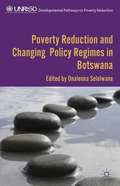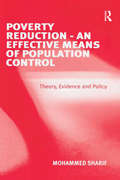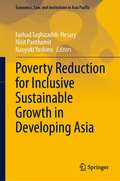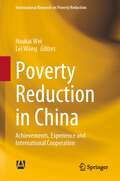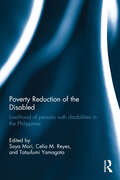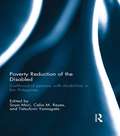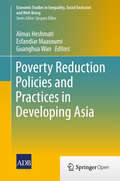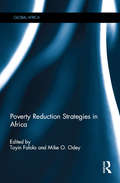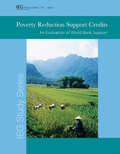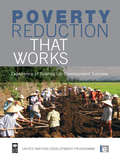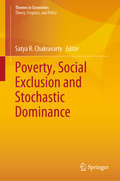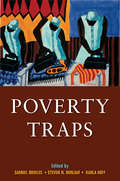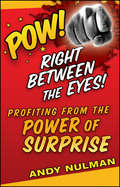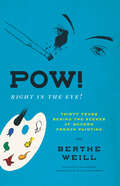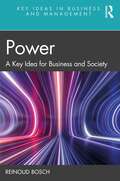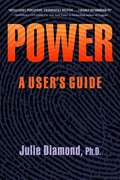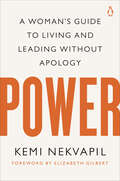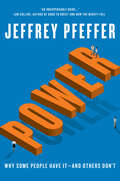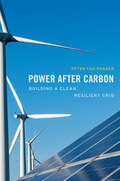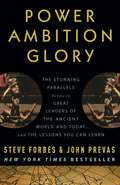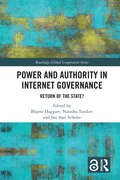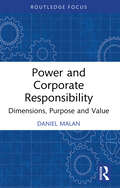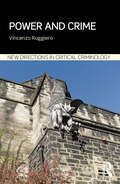- Table View
- List View
Poverty Reduction and Changing Policy Regimes in Botswana (Developmental Pathways to Poverty Reduction)
by Onalenna SelolwaneAn examination of how Botswana overcame the legacies of exceptional resource deficiency and colonial neglect, to transform itself from one of the poorest nations of the world to a middle income economy. Contributions review how economic, social and institutional policies interacted to produce successful poverty reduction.
Poverty Reduction - An Effective Means of Population Control: Theory, Evidence and Policy
by Mohammed SharifThis book contends that high fertility is rational in that it achieves short term economic benefit and long term old age-support for families. Wider macroeconomic effects are not the concern of the individual family. This means that the fertility choices of the poor are not a result of ignorance. The objective of this book is to drive home the fact that it is poverty that is responsible for high fertility and that until the problem of poverty is effectively dealt with the problem of high fertility will continue to persist. The book concludes with a series of policy recommendations for the eradication of poverty.
Poverty Reduction for Inclusive Sustainable Growth in Developing Asia (Economics, Law, and Institutions in Asia Pacific)
by Farhad Taghizadeh-Hesary Nisit Panthamit Naoyuki YoshinoThis book provides practical policy recommendations that are useful for developing Asia and for accelerating poverty reduction plans in the rest of the world. Poverty reduction in all its forms remains one of the greatest challenges facing humanity. In developing Asia, rapid growth in countries and sub-regions such as China, India, and Southeast Asia has lifted millions out of poverty, but progress has been uneven. On the other hand, the current coronavirus (COVID-19) pandemic and the global economic recession that it has caused are pushing millions of people back into poverty. Poverty reduction, inclusive growth, and sustainable development are inseparable, and poverty reduction is the premise for sustainable development. The Sustainable Development Goals (SDGs) are a bold commitment to finish what we started and end poverty in all forms and dimensions by 2030. However, because of the current global recession, the world is not on track to end poverty by 2030. Given the aforementioned situation, if we plan to achieve the no-poverty target in line with the SDGs, governments need to reconsider their policies and economies need to allocate their resources for this aim. Owing to the importance of the topic, this book provides several thematic and empirical studies on the roles of small and medium-sized enterprises, local businesses and trusts, international remittances and microfinance, energy security and energy efficiency in poverty reduction, and inclusive growth.
Poverty Reduction in China: Achievements, Experience and International Cooperation (International Research on Poverty Reduction)
by Houkai Wei Lei WangThis book provides a systematic overview of China's achievements in eliminating absolute poverty by 2020 under current standards. The book is divided into three parts: The first part is a study of major policy practices with distinctive characteristics in China's poverty alleviation practices; the second part is a study of China's international cooperation in poverty alleviation; the third part is a study of China's poverty alleviation by international scholars from the perspective of international cooperation and international comparison. These reports pay attention to China's achievements and experiences in poverty alleviation and reflect on how to strengthen cooperation with China in poverty alleviation.
Poverty Reduction of the Disabled: Livelihood of persons with disabilities in the Philippines
by Soya Mori Celia M. Reyes Tatsufumi YamagataA third of poor people are disabled in the developing world. How much do we know about their livelihood with hard data? Are they entirely powerless and dependent on family members? How do they earn income? These questions have become more important than ever, now that persons with disabilities (PWDs) in developing countries have awakened to rights and entitlements and that the international community started considering the incorporation of disability into the context of poverty reduction. This book highlights opportunities and challenges faced by PWDs in the developing countries.This book also illustrates the analyses with a case study which was conducted in the Philippines and this case study has made a good progress in legislation for PWDs. A field survey was jointly conducted by the Institute of Developing Economies, Japan, and the Philippine Institute for Development Studies in Metro Manila, the capital city of the Philippines, in 2008. Around 400 PWDs were interviewed, and the data was investigated with econometrics. The book highlights a remarkable disparity in earnings and education among PWDs. The book also examines the positive role of organizations such as Disabled People’s Organizations and how empowerment of PWDs is made through dissemination of useful information such as programs given by the central and local governments.The book concludes that all measures, i.e. education, training, DPOs and institutional preferences, must be mobilized harmoniously to boost the livelihood of PWDs sinking in the bottom stratum in income.
Poverty Reduction of the Disabled: Livelihood of persons with disabilities in the Philippines
by Tatsufumi Yamagata Soya Mori Celia M ReyesA third of poor people are disabled in the developing world. How much do we know about their livelihood with hard data? Are they entirely powerless and dependent on family members? How do they earn income? These questions have become more important than ever, now that persons with disabilities (PWDs) in developing countries have awakened to rights and entitlements and that the international community started considering the incorporation of disability into the context of poverty reduction. This book highlights opportunities and challenges faced by PWDs in the developing countries. This book also illustrates the analyses with a case study which was conducted in the Philippines and this case study has made a good progress in legislation for PWDs. A field survey was jointly conducted by the Institute of Developing Economies, Japan, and the Philippine Institute for Development Studies in Metro Manila, the capital city of the Philippines, in 2008. Around 400 PWDs were interviewed, and the data was investigated with econometrics. The book highlights a remarkable disparity in earnings and education among PWDs. The book also examines the positive role of organizations such as Disabled People’s Organizations and how empowerment of PWDs is made through dissemination of useful information such as programs given by the central and local governments. The book concludes that all measures, i.e. education, training, DPOs and institutional preferences, must be mobilized harmoniously to boost the livelihood of PWDs sinking in the bottom stratum in income.
Poverty Reduction Policies and Practices in Developing Asia
by Almas Heshmati Esfandiar Maasoumi Guanghua WanThis book looks at the major policy challenges facing developing Asia and how the region sustains rapid economic growth to reduce multidimensional poverty through socially inclusive and environmentally sustainable measures. Asia is facing many challenges arising from population growth, rapid urbanization, provision of services, climate change and the need to redress declining growth after the global financial crisis. This book examines poverty and related issues and aims to advance the development of new tools and measurement of multidimensional poverty and poverty reduction policy analysis. The book covers a wide range of issues, including determinants and causes of poverty and its changes; consequences and impacts of poverty on human capital formation, growth and consumption; assessment of poverty strategies and policies; the role of government, NGOs and other institutions in poverty reduction; rural-urban migration and poverty; vulnerability to poverty; breakdown of poverty into chronic and transitory components; and a comparative study on poverty issues in Asia and other regions. The book will appeal to all those interested in economic development, resources, policies and economic welfare and growth.
Poverty Reduction Strategies in Africa: The Ideology Of The Family-state (Global Africa)
by Toyin Falola and Mike O. OdeyA fundamental question about contemporary Africa is why does Africa remain so poor, long after the departure of the European Colonial domination and in the midst of so many natural resources? Poverty Reduction Strategies in Africa provides new understandings of the persistent issue of poverty in Sub-Saharan Africa and makes recommendations for policy frameworks to help African governments alleviate poverty. Each chapters uses case studies to review the old strategies for resolving the problem of poverty in the continent and make the case for new initiatives to address poverty. The contributors focus on practical and day-to-day issues as the best approach to formulate and implement poverty reduction strategies in contemporary Africa. This book is invaluable reading for students and scholars of African politics and development.
Poverty Reduction Support Credits: An Evaluation of World Bank Support
by World BankThis evaluation examines the relevance and effectiveness of Poverty Reduction Support Credits (PRSCs), introduced by the Bank in early 2001 to support comprehensive growth, improve social conditions, and reduce poverty in IDA countries. PRSCs were intended to allow greater country-ownership, provide more predictable annual support, exhibit more flexible conditionality, and strengthen budget processes in a results-based framework. By September 2009, the Bank had approved 99 PRSCs totaling some $7.5 billion and representing 38% percent of IDA policy based lending. The evaluation finds that in terms of process, PRSCs were effective in easing conditionality, increasing country ownership and aid predictability, stimulating dialogue between central and sectoral ministries, and improving donor harmonization. In terms of content, PRSCs succeeded in emphasizing public sector management and pro-poor service delivery. Yet in terms of results, it is difficult to distinguish growth and poverty outcomes in countries with PRSCs from other better performing IDA countries. There is scope for further simplifying the language of conditionality and underpinning PRSCs with better pro-poor growth diagnostics. PRSCs can also strengthen their results frameworks and limit sector policy content in multi-sector DPLs to high-level or cross-cutting issues. Today, Bank policy has subsumed PRSCs under the broader mantle of Development Policy Lending and the rationale for a separate 'brand name' although differences linger from the past. Since PRSCs and other policy-based lending have gradually converged in design, remaining differences compared to other Development Policy Loans should be clearly spelled out, or the separate PRSC brand name should be phased out.
Poverty Reduction that Works: Experience of Scaling Up Development Success
by Paul Steele Neil Fernando Maneka Weddikkara�This book provides an excellent framework to analyse the experience of a wide variety of successful initiatives across the world and draws attention to critical issues that practitioners need to think about when designing poverty reduction interventions and scaling up.� Bill Tod, Regional MDG Adviser, SNV Asia �With its wide regional coverage, and frank discussions of issues and problems encountered in designing projects that directly tackle poverty, this will be a very useful reference book for NGOs, INGOs, and also for multilateral institutions.� Johanna Boestel, Country Economist, Asian Development Bank, Sri Lanka Resident Mission We are now at the midpoint for achieving the Millennium Development Goals and the objective of halving poverty by 2015. Despite commendable efforts and much progress, up to 750 million people are still living in absolute poverty. To lift these people out of poverty, macro-economic policies must be complemented by targeted and local level poverty reduction. This book looks at twenty of the most innovative case studies of poverty reduction and Millennium Development Goal localization from fifteen countries - Afghanistan, Bangladesh, Cambodia, China, Egypt, India, Indonesia, Malaysia, Mexico, Nepal, Paraguay, Philippines, Sri Lanka, Thailand and Vietnam - covering diverse issues ranging from housing and tourism to socio-economic empowerment of women, health insurance and markets for livestock produce. Many of the cases started as small scale interventions by NGOs, donors or government pilots but now they are being scaled up to form part of national policy or replicated across their respective countries. Yet why do some work while others do not? What are the stumbling blocks and how can they be overcome? And what lessons and principles are there for replicating and scaling up poverty reduction initiatives worldwide? This book tackles these questions and more, and presents a wealth of knowledge, evidence and ideas for all practitioners and researchers working to reduce poverty at the local level while aiming to achieve a global impact. Published with UNDP
Poverty, Social Exclusion and Stochastic Dominance (Themes in Economics)
by Satya R. ChakravartyThis book honors the memory of Tony Atkinson, who made significant contributions to the rigorous study of income inequality, poverty, and redistribution. These essays presented, covering a span of over 30 years of research and scholarship, have been at the forefront of distributional analysis, and many of them are of prime importance for contemporary developments in the real-valued measurement of poverty and inequality, with particular reference to the concepts of fuzzy poverty assessment, vulnerability, heterogeneity/multidimensionality, unit consistency, sub-group decomposability, and dominance criteria. While all of these articles have been previously published—singly or with co-authorship—in a number of professional journals or distinguished edited volumes, this book is greatly enriched by a substantial introductions by the authors, which place the contributions in context, highlights their inter-connectedness, and relates them to the work of Tony Atkinson and other scholars. This book is of intrinsic value to welfare analysts, as well as being a tribute to a very great scholar by a fellow economist.
Poverty Traps
by Karla Hoff Steven N. Durlauf Samuel BowlesMuch popular belief--and public policy--rests on the idea that those born into poverty have it in their power to escape. But the persistence of poverty and ever-growing economic inequality around the world have led many economists to seriously question the model of individual economic self-determination when it comes to the poor. In Poverty Traps, Samuel Bowles, Steven Durlauf, Karla Hoff, and the book's other contributors argue that there are many conditions that may trap individuals, groups, and whole economies in intractable poverty. For the first time the editors have brought together the perspectives of economics, economic history, and sociology to assess what we know--and don't know--about such traps. Among the sources of the poverty of nations, the authors assign a primary role to social and political institutions, ranging from corruption to seemingly benign social customs such as kin systems. Many of the institutions that keep nations poor have deep roots in colonial history and persist long after their initial causes are gone. Neighborhood effects--influences such as networks, role models, and aspirations--can create hard-to-escape pockets of poverty even in rich countries. Similar individuals in dissimilar socioeconomic environments develop different preferences and beliefs that can transmit poverty or affluence from generation to generation. The book presents evidence of harmful neighborhood effects and discusses policies to overcome them, with attention to the uncertainty that exists in evaluating such policies.
Pow! Right Between the Eyes
by Andy NulmanPow! Radical new methods for reaching jaded, cynical consumersPut simply, when it comes to your business, your new idea, even yourself, this book can be the difference between a "Who cares?" and a "Holy cow!"Business, both big and small, is in desperate need of new ways to inspire bored and cynical consumers who have grown weary of the same old song and dance. In today's information economy, it doesn't matter how many people you reach, but how much attention they pay. And the best way to get attention is with the powerful, but largely misunderstood, element of surprise.Pow! Enter Andy Nulman with the art of surprise marketing. An explosive new outlook, surprise marketing solidifies the bond between you and your customers like nothing else, and keeps them coming back for more by providing a continuous flow of what they never expected. Pow! Right Between the Eyes reveals the secrets, theories, and tactics of surprise marketing, and wields outrageous real-world examples (and even more outrageous tools like "The Lubricant to Yes" and "Euphoric Shock") to help expand the boundaries of the extreme and create a bigger bang for bigger profits.On his quest to unlock the secret of why some things knock your socks off and others put you to sleep, Nulman shares insights from director Alfred Hitchcock, designer Philippe Starck, playwright David Mamet, Family Guy creator Seth McFarlane, Harvard psychologists, songwriters, bloggers, and even the inventor of Pirate Booty snack chips. And he shows how today's smartest companies are winning big with surprises stories like:* How Oprah's shocking announcement that "Everybody gets a car!" sent her Web site traffic up 800% and helped the Pontiac G6 outsell its competitors by 20%* How Target earns $7 billion a year in free publicity with stunts like a floating temporary store in New York's Hudson River or putting on a vertical fashion show where acrobat models walked down the side of Rockefeller Center* How Bear Naked Granola reversed the trick-or-treat tradition by sending costumed street teams door-to-door to give away granola samples on HalloweenAndy Nulman is a wildly-successful businessman and even wilder public speaker who first learned the power of surprise working with Jay Leno, Jerry Seinfeld, Jim Carrey, and many other comedians as the cofounder and CEO of the Just For Laughs Festival, the world's largest comedy event. His book shares hilarious and effective surprise promotions that he himself dreamed up for the event and in his current position as cofounder, President, and CMO of Airborne Mobile, which brings brands like Maxim, Family Guy, and the NFL to the mobile media world.Don't forget to read the book's two forewords by the legendary John Cleese and CBS Late Late Show host Craig Ferguson. Surprising choices for a business book? Well...what did you expect?
Pow! Right in the Eye!: Thirty Years behind the Scenes of Modern French Painting (Abakanowicz Arts and Culture Collection)
by Berthe WeillMemoir of a provocative Parisian art dealer at the heart of the 20th-century art world, available in English for the first time. Berthe Weill, a formidable Parisian dealer, was born into a Jewish family of very modest means. One of the first female gallerists in the business, she first opened the Galerie B. Weill in the heart of Paris’s art gallery district in 1901, holding innumerable exhibitions over nearly forty years. Written out of art history for decades, Weill has only recently regained the recognition she deserves. Under five feet tall and bespectacled, Weill was beloved by the artists she supported, and she rejected the exploitative business practices common among art dealers. Despite being a self-proclaimed “terrible businesswoman,” Weill kept her gallery open for four decades, defying the rising tide of antisemitism before Germany’s occupation of France. By the time of her death in 1951, Weill had promoted more than three hundred artists—including Henri Matisse, Pablo Picasso, Amedeo Modigliani, Diego Rivera, and Suzanne Valadon—many of whom were women and nearly all young and unknown when she first exhibited them. Pow! Right in the Eye! makes Weill’s provocative 1933 memoir finally available to English readers, offering rare insights into the Parisian avant-garde and a lively inside account of the development of the modern art market.
Pow! Right in the Eye!: Thirty Years behind the Scenes of Modern French Painting (Abakanowicz Arts and Culture Collection)
by Berthe WeillMemoir of a provocative Parisian art dealer at the heart of the 20th-century art world, available in English for the first time. Berthe Weill, a formidable Parisian dealer, was born into a Jewish family of very modest means. One of the first female gallerists in the business, she first opened the Galerie B. Weill in the heart of Paris’s art gallery district in 1901, holding innumerable exhibitions over nearly forty years. Written out of art history for decades, Weill has only recently regained the recognition she deserves. Under five feet tall and bespectacled, Weill was beloved by the artists she supported, and she rejected the exploitative business practices common among art dealers. Despite being a self-proclaimed “terrible businesswoman,” Weill kept her gallery open for four decades, defying the rising tide of antisemitism before Germany’s occupation of France. By the time of her death in 1951, Weill had promoted more than three hundred artists—including Henri Matisse, Pablo Picasso, Amedeo Modigliani, Diego Rivera, and Suzanne Valadon—many of whom were women and nearly all young and unknown when she first exhibited them. Pow! Right in the Eye! makes Weill’s provocative 1933 memoir finally available to English readers, offering rare insights into the Parisian avant-garde and a lively inside account of the development of the modern art market.
Power: A Key Idea for Business and Society (Key Ideas in Business and Management)
by Reinoud BoschPower plays a central role in business and management. But what is power exactly, and what are key elements of this concept? Defining power as relative ability, this book discusses structures of power, individual power, the exercise of power, strategy, and collective power. While discussing these key components, ideas of important thinkers about power, from Plato to Foucault, Weber to Lukes, Machiavelli to Kahneman, Sun to Kotter, and Barnard to Clegg, are discussed and interpretively categorized into a toolbox of conceptual elements – what Blumer referred to as sensitizing concepts. This toolbox of sensitizing concepts allows the selection of those elements of the concept of power that provide the most constructive and effective practical understanding in particular situations. The core message behind the discussion is that knowledge of key components of the concept of power is empowering. It is empowering to learn about aspects of structures of power, individual power, the exercise of power, strategy, and collective power. Understanding such conceptual components empowers students, researchers, practitioners, and other readers to use their understanding in interpreting, theorizing about, and dealing with the complexities of power in their particular situations – without tying them to any preconceived general theories about power.
Power: A User's Guide
by Julie DiamondUsing power well is more than a matter of good intentions. The path toward ethical, authentic, and effective use of power starts with this book. Combining cutting-edge psychological theory with practical exercises, real-world accounts of leadership challenges, and the author's personal stories from her career as a facilitator and coach, it aims to develop the reader's external authority to navigate high-power roles and responsibilities, and to find personal power within.
Power: Nobody Should Have Too Much
by Arie De GeusThis chapter illustrates how the ideal system of corporate governance provides continuity, with all the requirements that nurture a living company and a human community, without absolute power concentrated in the hands of either shareholders or management.
Power: A Woman's Guide to Living and Leading Without Apology
by Kemi Nekvapil"This book is a miraculous event." –Elizabeth Gilbert, from the forewordA transformative path for women to reclaim their power in a world all too eager to strip it awayWomen know what it&’s like to feel powerless. We have had power taken from us and used over us, and sometimes we have had to give it away for our own safety. But when power is built internally, it is stronger and more enduring than that bestowed externally. In Power, renowned leadership coach Kemi Nekvapil introduces a new framework for cultivating your power from the inside out.When you tap into the power that comes from within, you have the capacity to rebuild yourself. You give yourself the opportunity to break free from chronic people-pleasing and start making choices that align with your needs and values. You stop living and leading with apology, and instead use your power as a force for good.Through the principles of Presence, Ownership, Wisdom, Equality, and Responsibility, Power invites you to stop waiting for power to be handed to you and instead choose it for yourself and on your own terms. Drawing on stories from her own life as a Black woman in a society where power is often used as a tool for fear and obedience, and from the lives of leaders, gamechangers, and everyday women who&’ve learned to step into their power, Nekvapil shows you how to practice, build, and feel your inner force.
Power: Why Some People Have It -- and Others Don't
by Jeffrey PfefferIn this crowning achievement, one of the greatest minds in management theory reveals how to succeed and wield power in the real world. <P><P> Over decades of consulting with corporations and teaching MBA students the nuances of organizational power, Jeffrey Pfeffer has watched numerous people suffer career reversals even as others prevail despite the odds. <P><P> Our most common mistake is not having a realistic understanding of what makes some people more successful than others. By believing that life is fair, we tend to subscribe to the "just-world phenomenon," which leaves us unprepared for the challenges and competition of the real world. <P><P> Now Pfeffer brings decades of his incredible insights to a wider audience. Brimming with counterintuitive advice, numerous examples from various countries, and surprising findings based on his research, this groundbreaking guide reveals the strategies and tactics that separate the winners from the losers. Power, he argues, is a force that can be used and harnessed not only for individual gain but also for the benefit of organizations and society. Power, however, is not something that can be learned from those in charge-their advice often puts a rosy spin on their ascent and focuses on what should have worked, rather than what actually did. Instead, Pfeffer reveals the true paths to power and career success. Iconoclastic and grounded in the realpolitik of human interaction, Power is an essential organizational survival manual and a new standard in the field of leadership and management.
Power after Carbon: Building a Clean, Resilient Grid
by Peter Fox-PennerAs the electric power industry faces the challenges of climate change, technological disruption, new market imperatives, and changing policies, a renowned energy expert offers a roadmap to the future of this essential sector. As the damaging and costly impacts of climate change increase, the rapid development of sustainable energy has taken on great urgency. The electricity industry has responded with necessary but wrenching shifts toward renewables, even as it faces unprecedented challenges and disruption brought on by new technologies, new competitors, and policy changes. The result is a collision course between a grid that must provide abundant, secure, flexible, and affordable power, and an industry facing enormous demands for power and rapid, systemic change. The fashionable solution is to think small: smart buildings, small-scale renewables, and locally distributed green energy. But Peter Fox-Penner makes clear that these will not be enough to meet our increasing needs for electricity. He points instead to the indispensability of large power systems, battery storage, and scalable carbon-free power technologies, along with the grids and markets that will integrate them. The electric power industry and its regulators will have to provide all of these, even as they grapple with changing business models for local electric utilities, political instability, and technological change. Power after Carbon makes sense of all the moving parts, providing actionable recommendations for anyone involved with or relying on the electric power system.
Power Ambition Glory: The Stunning Parallels Between Great Leaders of the Ancient World and Today... and the Lessons You Can Learn
by Steve Forbes John PrevasBased on an extraordinary collaboration between Steve Forbes, chairman, CEO, and editor in chief of Forbes Media, and classics professor John Prevas, Power Ambition Glory provides intriguing comparisons between six great leaders of the ancient world and contemporary business leaders. * Great leaders not only have vision but know how to build structures to effect it. Cyrus the Great did so in creating an empire based on tolerance and inclusion, an approach highly unusual for his or any age. Jack Welch and John Chambers built their business empires using a similar approach, and like Cyrus, they remain the exceptions rather than the rule. * Great leaders know how to build consensus and motivate by doing what is right rather than what is in their self-interest. Xenophon put personal gain aside to lead his fellow Greeks out of a perilous situation in Persia-something very similar to what Lou Gerstner and Anne Mulcahy did in rescuing IBM and Xerox.* Character matters in leadership. Alexander the Great had exceptional leadership skills that enabled him to conquer the eastern half of the ancient world, but he was ultimately destroyed by his inability to manage his phenomenal success. The corporate world is full of similar examples, such as the now incarcerated Dennis Kozlowski, who, flush with success at the head of his empire, was driven down the highway of self-destruction by an out-of-control ego.* A great leader is one who challenges the conventional wisdom of the day and is able to think out of the box to pull off amazing feats. Hannibal did something no one in the ancient world thought possible; he crossed the Alps in winter to challenge Rome for control of the ancient world. That same innovative way of thinking enabled Serge Brin and Larry Page of Google to challenge and best two formidable competitors, Microsoft and Yahoo!* A leader must have ambition to succeed, and Julius Caesar had plenty of it. He set Rome on the path to empire, but his success made him believe he was a living god and blinded him to the dangers that eventually did him in. The parallels with corporate leaders and Wall Street master-of-the-universe types are numerous, but none more salient than Hank Greenberg, who built the AIG insurance empire only to be struck down at the height of his success by the corporate daggers of his directors. * And finally, leadership is about keeping a sane and modest perspective in the face of success and remaining focused on the fundamentals-the nuts and bolts of making an organization work day in and day out. Augustus saved Rome from dissolution after the assassination of Julius Caesar and ruled it for more than forty years, bringing the empire to the height of its power. What made him successful were personal humility, attention to the mundane details of building and maintaining an infrastructure, and the understanding of limits. Augustus set Rome on a course of prosperity and stability that lasted for centuries, just as Alfred Sloan, using many of the same approaches, built GM into the leviathan that until recently dominated the automotive business.From the Hardcover edition.
Power and Authority in Internet Governance: Return of the State? (ISSN)
by Jan Aart Scholte Blayne Haggart Natasha TusikovPower and Authority in Internet Governance investigates the hotly contested role of the state in today's digital society. The book asks: Is the state "back" in internet regulation? If so, what forms are state involvement taking, and with what consequences for the future?The volume includes case studies from across the world and addresses a wide range of issues regarding internet infrastructure, data and content. The book pushes the debate beyond a simplistic dichotomy between liberalism and authoritarianism in order to consider also greater state involvement based on values of democracy and human rights. Seeing internet governance as a complex arena where power is contested among diverse non-state and state actors across local, national, regional and global scales, the book offers a critical and nuanced discussion of how the internet is governed – and how it should be governed.Power and Authority in Internet Governance provides an important resource for researchers across international relations, global governance, science and technology studies and law as well as policymakers and analysts concerned with regulating the global internet.The Open Access version of this book, available at http://www.taylorfrancis.com, has been made available under a Creative Commons Attribution-Non Commercial-No Derivatives (CC-BY-ND) 4.0 license.
Power and Corporate Responsibility: Dimensions, Purpose and Value (Routledge CoBS Focus on Responsible Business)
by Daniel MalanPower and Corporate Responsibility explores the concept of corporate responsibility and offers a systematic discussion by referring to the following dimensions: understanding responsibility, taking responsibility, governing responsibility, managing responsibility, investing in responsibility, reporting on responsibility and regulating responsibility. The aim of the book is to provide a user-friendly but theoretically grounded overview of the core dimensions of CR. The seven dimensions of CR are not offered as a definitive framework, but rather a flexible conceptual framework that is compatible with acknowledged thought leadership in the field. The author uses his diverse academic background, as well as his practitioner background, to debunk some of the myths associated with CSR using mini case studies, but also to illustrate the strategic importance of the concept of CR. This accessible book will be a valuable resource for business management scholars, instructors and upper-level students, and those with a particular interest in business ethics, CSR and corporate governance. It will also serve as a guide for participants in executive education courses.
Power and Crime (New Directions in Critical Criminology)
by Vincenzo RuggieroThis book provides an analysis of the two concepts of power and crime and posits that criminologists can learn more about these concepts by incorporating ideas from disciplines outside of criminology. Although arguably a 'rendezvous' discipline, Vincenzo Ruggiero argues that criminology can gain much insight from other fields such as the political sciences, ethics, social theory, critical legal studies, economic theory, and classical literature. In this book Ruggiero offers an authoritative synthesis of a range of intellectual conceptions of crime and power, drawing on the works and theories of classical, as well as contemporary thinkers, in the above fields of knowledge, arguing that criminology can ‘humbly’ renounce claims to intellectual independence and adopt notions and perspectives from other disciplines. The theories presented locate the crimes of the powerful in different disciplinary contexts and make the book essential reading for academics and students involved in the study of criminology, sociology, law, politics and philosophy.
